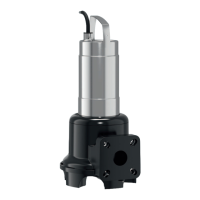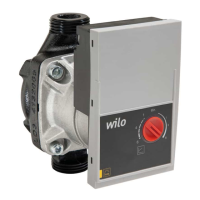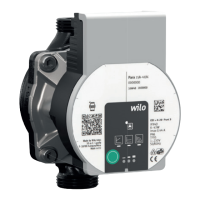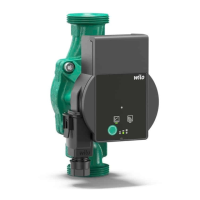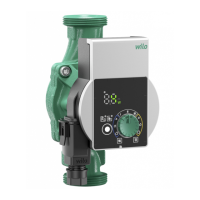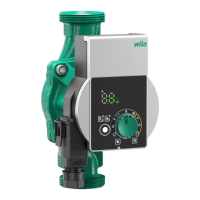en Shut-down/dismantling
18 WILO SE 2019-02
Pump with attached float switch and plug
ƒ Single-phase current version: After inserting the plug into the
socket, the pump is ready for operation. The pump is switched
on and off automatically depending on the fill level.
ƒ Three-phase current version: After inserting the plug into the
socket, the pump is ready for operation. The pump is con-
trolled via two switches on the plug:
– MANUAL/AUTO: Determines if the pump is switched on
and off directly (MANUAL) or depending on the fill level
(AUTO).
– ON/OFF: Switch pump on and off.
Pump with vertical float switch
After inserting the plug into the socket, the pump is ready for op-
eration. The pump is switched on/off depending on the selected
operating mode of the float switch:
ƒ “AUTO” operating mode: The pump switches on and off de-
pending on the fill level.
ƒ “MANUEL” operating mode: The pump switches on immedi-
ately after the plug has been inserted into the socket.
NOTICE!Set the operating mode at the switch. The switch is
located above the upper float switch.
Pump with attached plug
ƒ Single-phase current version: After inserting the plug in the
socket, the pump is switched on.
ƒ Three-phase current version: After inserting the plug into the
socket, the pump is ready for operation. The pump is switched
on and off with the ON/OFF switch.
Pumps with bare cable end
The pump must be switched on and off using a separate operat-
ing point (on/off switch, switchgear) provided by the customer.
7.6 During operation
WARNING
Amputation of limbs due to rotating compon-
ents!
No persons must be present in the work area of the
pump! There is risk of (serious) injuries due to rotat-
ing components! No persons must be present in the
work area of the pump during start-up or operation.
WARNING
Risk of burns from hot surfaces!
Motor housing can become hot during operation. It
may cause burns. Allow the pump to cool down at
ambient temperature after switching it off!
NOTICE
Pumping problems due to water level being
too low
The hydraulics are self-venting. Smaller air cushions
are resorbed during pumping. If the fluid is lowered
too much, separation of the volume flow may occur.
The minimum permissible water level must reach the
upper edge of the hydraulics housing!
When operating the pump, observe the locally applicable regula-
tions on the following topics:
ƒ Work safety
ƒ Accident prevention
ƒ Handling electrical machines
Strictly adhere to the responsibilities of the personnel specified
by the operator. All personnel are responsible for ensuring that
the responsibilities of the personnel and the regulations are ob-
served!
Due to their design, centrifugal pumps have rotating parts that
are easily accessible. Depending on the operating condition,
sharp edges can develop on these parts. WARNING!This can lead
to cuts and limbs may be severed! Check the following at regu-
lar intervals:
ƒ Operating voltage (+/-10% of the rated voltage)
ƒ Frequency (+/-2% of the rated frequency)
ƒ Power consumption between individual phases (max.5%)
ƒ Voltage difference between the individual phases (max.1%)
ƒ Max. switching frequency
ƒ Minimum water submersion depending on the operating mode
ƒ Inlet: no air intake
ƒ Level control device/dry-running protection: Switching points
ƒ Quiet/low-vibration running
ƒ All gate valves open
8 Shut-down/dismantling
8.1 Personnel qualifications
ƒ Operation/control: Operating personnel must be instructed in
the functioning of the complete system.
ƒ Electrical work: A qualified electrician must carry out the elec-
trical work.
ƒ Installation/dismantling: The technician must be trained in the
use of the necessary tools and fixation materials for the relev-
ant construction site.
8.2 Operator responsibilities
ƒ Locally applicable accident prevention and safety regulations
of trade associations.
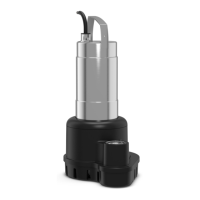
